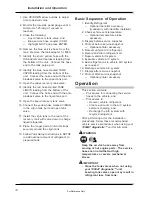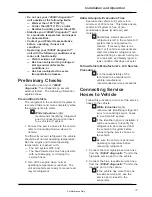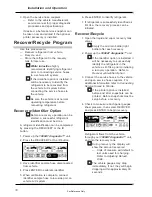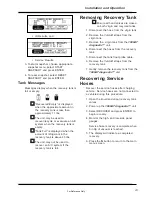
9
Introduction
WARNING
• Use your
1090AT diagnostic™ unit in
locations with mechanical ventilation
providing at least four air changes per
hour.
• Avoid breathing air conditioning
refrigerant and lubricant vapor or mist.
• Do not allow refrigerant to contact
open flame or be drawn into a running
engine. This can cause refrigerant to
become poisonous phosgene gas.
• Use your
1090AT diagnostic
™ unit to
remove refrigerant from automotive air
conditioning systems only.
• Read, understand and follow
Safety
Information in the front of this manual.
IMPORTANT
Tighten all tubing and hose connections
properly. Insufficient or excessive torque
can result in loose joints or deformed
parts. Either condition can result in
refrigerant leakage.
Refrigerant Substitute Warning
WARNING
• Do not use your
1090AT diagnostic™
unit or leak detector equipment if R-12
substitutes are suspected. R-12
refrigerant substitutes may be
flammable.
• Read, understand and follow
Safety
Information in the front of this manual.
Aftermarket R-12 refrigerant substitutes are
being sold that are dangerous or potentially
flammable gases. These products contain a
blend of butane, isobutane and propane and
have the potential for explosion. Some of
these products are:
• OZ-12,
• Refrigerant-176,
• Arctic Chill R-176, and
• GHG Refrigerant 12.
Some vehicles using OZ-12 can be
identified by a label that may be placed in
the engine compartment, but many cannot
be identified. Studies are currently being
conducted to develop a procedure to identify
the type of refrigerant in a refrigerant
system. State agencies and the
Environmental Protection Agency (EPA) are
moving to ban flammable substitutes.
If it is suspected that a refrigerant system
contains a product of this type:
• Question customers about previous
service,
• Be aware of any unfamiliar odor from the
system,
• Do not use any leak detector,
• Do not use recycling equipment, and
• Contact your state fire marshall or local
EPA office.
Refrigerant Oils
In mobile air conditioning units, the lubricant
needed for the compressor is blended with
the refrigerant. Mineral (petroleum) oils
were used with R-12 systems. Mineral oils
are not soluble in R-134a and the industry
had to substitute synthetic lubricating fluids
for the mineral oils. Polyalkylene glycol oils
(PAGs) were the first synthetics to meet the
auto A/C compressor manufacturers
performance criteria, and most automakers
and compressor manufacturers devised their
retrofit specifications with PAGs in mind.
Since then, polyol ester oils (ESTERS or
POEs) have been tested and also have
been found to meet the the performance
criteria. Although POEs have not been
approved by the automakers or A/C
compressor manufacturers, POEs are
frequently used in A/C retrofits in the
automotive aftermarket.
For Reference Only


























